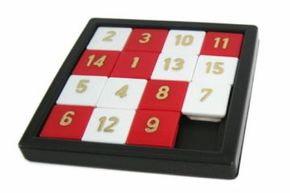Before you read any further, you should be aware of reports that sliding puzzles can cause insanity. There's no doubt they're addictive and they've certainly made some puzzle solvers tear out their hair and swear a blue streak. When the first sliding puzzle was invented it set off a worldwide craze. That same simple puzzle is still challenging puzzle solvers more than a century later.
Sliding puzzles are cousins of mechanical puzzles, like those that require you to disentangle two twisted nails or to fit a collection of blocks into a cube. They're also related to jigsaw puzzles and to mazes. Rubik's Cube is a 3-D variation on a sliding puzzle.
Advertisement
Most sliding puzzles are two-dimensional. The pieces cannot be lifted out of the frame or rearranged in any way, except by sliding them into an empty space. They are also called sliding-block puzzles or simply sliders. The goal of a sliding puzzle is to arrange the pieces in a particular pattern. That might mean putting together the elements of a picture, forming a shape, or creating an array of numbers or letters. Movement of the pieces is restricted so that you have to move one piece in order to shift another. That's where the madness comes in.
What makes sliding puzzles so alluring? The best of them are deceptively simple in appearance. They might involve rearranging only a half-dozen pieces. A child can understand the idea, and it might look like child's play to solve the puzzle. You don't have to learn any complicated rules. Yet the solution can be so complex that it seems impossible. Some solutions involve 100 moves or more. The puzzles demand logic, problem-solving and sequential thinking skills, combined with a dash of intuition and a healthy amount of patience.
Sliding puzzles started as actual mechanical devices, blocks of wood or plastic in a frame. But they were easy to translate into computer programs and to offer over the Internet. Hundreds of sliding puzzles are available online, and now you can play sliding puzzles on your smartphones and mobile devices.
In the next section, you'll read about the wacky history of these diabolical gadgets.



